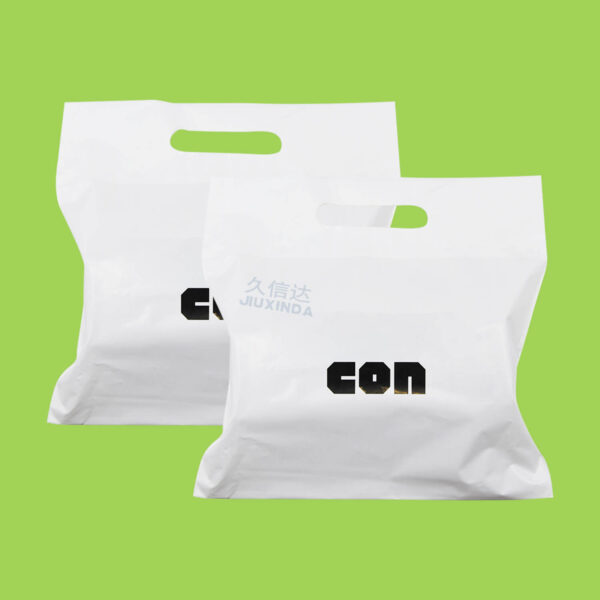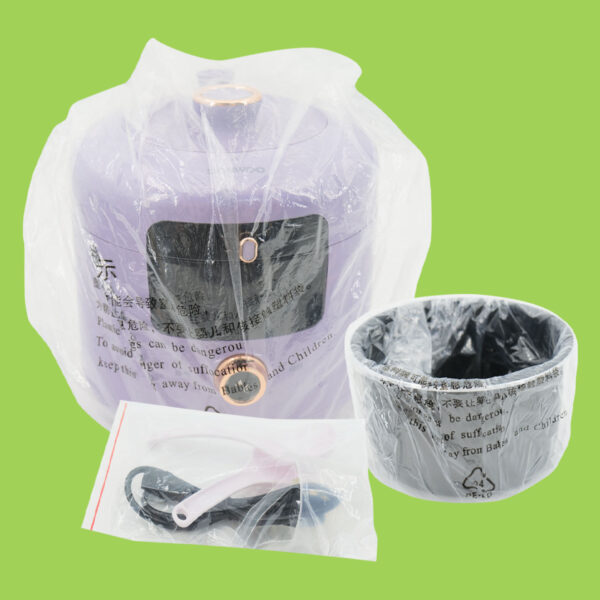In today’s society, plastic products are ubiquitous in our lives, from food packaging to electronic product shells, from daily necessities to industrial parts, plastics are widely used for their advantages of lightweight, durability and low cost. However, with the increasing awareness of environmental protection, people are more and more concerned about the environmental impact of traditional plastic products. Against this background, PCR plastics have emerged as a highly regarded environmentally friendly material. In this article, we will introduce the definition and characteristics of PCR plastics as well as the advantages and disadvantages of PCR bags in detail.
Contents
I. Definition and sources of PCR plastics
PCR stands for “Post – Consumer Recycled”, which means “Post Consumer Recycled”, PCR plastics are plastic materials made from plastic products that have been recycled after consumer use and reprocessed. These post-consumer recycled plastics come from a wide range of sources, including discarded beverage bottles, food packaging bags, plastic tableware, toys, and more. Through professional recycling and reprocessing processes, these waste plastics are transformed into raw materials that can be used again in production, thus realizing the recycling of plastic resources.
The production process of PCR plastics mainly consists of the following steps: firstly, recycling of waste plastic products, which requires a perfect recycling system and active public participation; secondly, sorting and cleaning of recycled plastics to remove impurities and pollutants; then, crushing and melting of cleaned plastics to make granular regenerated plastics; and lastly, these regenerated plastic granules can be further processed to make various plastic products, such as bags, containers, pipes and so on.

Second, the advantages of PCR bags
(i) Environmental friendliness
The biggest advantage of PCR bags is their environmental friendliness. While the production of traditional plastic products relies on non-renewable resources such as oil, the production of PCR plastics utilizes post-consumer recycled plastics, reducing the exploitation and consumption of natural resources. In addition, discarded plastics can cause serious pollution to the environment, such as white pollution, soil pollution, and marine pollution if they are discarded haphazardly. Through recycling, these discarded plastics are effectively disposed of, reducing the negative impact of landfills and incineration on the environment, thereby reducing carbon emissions and helping to mitigate global climate change.
(ii) Cost-effectiveness
From an economic perspective, PCR plastics are relatively inexpensive to produce. Although the recycling and reprocessing process requires a certain amount of investment, because its raw materials are waste plastics, its cost is much lower than that of raw materials such as petroleum, which is required for the production of virgin plastics. Therefore, the use of PCR bags can reduce the production costs of enterprises to a certain extent and improve the competitiveness of products. For some cost-sensitive industries, such as food packaging, daily necessities packaging, etc., PCR bags are a very affordable choice.
(iii) Excellent performance
Although PCR plastic is a recycled material, its performance is not inferior to virgin plastic. After advanced reprocessing technology, PCR plastic can maintain better physical and chemical properties, such as strength, toughness, heat resistance, corrosion resistance, etc. PCR bags can meet most of the packaging needs, such as waterproof, moisture-proof, oil-proof, and good sealing. For example, in the field of food packaging, PCR bags can effectively protect the freshness and quality of food, preventing food from external pollution and oxidative deterioration. In the packaging of electronic products, PCR bags can provide good cushioning and protection to prevent products from being damaged during transportation.
(iv) Highly customizable
PCR bags can be customized according to different needs. Their appearance and functionality can be adjusted to meet specific customer requirements, such as color, size, shape, and printing patterns. This enables PCR bags to meet the packaging needs of a wide range of products, whether they are high-end luxury goods or general public consumer goods, you can find the right PCR bag solution. In addition, PCR plastics can be laminated with other materials to further improve the performance and functionality of the bags, such as increasing breathability, antimicrobial properties, and freshness retention, thus meeting more specific packaging requirements.
(v) Compliance with regulatory requirements
As environmental regulations become increasingly stringent, many countries and regions are placing clear requirements on the recyclability and environmental friendliness of plastic packaging. The use of PCR bags can help companies meet these regulatory requirements and avoid the legal risks and market restrictions they face for not meeting environmental standards. For example, some countries in the European Union require a certain percentage of recycled plastic content in packaging materials, and the use of PCR bags can easily meet this requirement, making products more competitive in the international market.

III. Disadvantages of PCR bags
(i) Quality stability issues
Since the raw material for PCR plastics is post-consumer recycled plastic, its sources are complex and diverse, and different batches of recycled plastics may differ in terms of composition, properties and impurity content. This may result in PCR bags having less consistent quality than virgin plastic bags. For example, in some cases, PCR bags may have insufficient strength, toughness and uneven color. Although these problems can be ameliorated to a certain extent through strict quality control and advanced processing technology, the possibility of quality fluctuations still cannot be completely eliminated. Therefore, in some applications that require very high packaging quality, such as high-end electronic product packaging, medical device packaging, etc., companies may be more inclined to choose virgin plastic packaging bags.
(ii) Color and appearance restrictions
The color and appearance of recycled plastics are affected by the raw material and it is often difficult to achieve the same pure and uniform appearance as virgin plastics.The color choices for PCR bags are relatively limited and there may be color differences. In addition, the surface of PCR bags may have spots, scratches or other imperfections due to impurities or contaminants that may remain from the recycling process. These cosmetic issues may affect the overall aesthetics of the product and may reduce consumers’ willingness to purchase for some products that emphasize brand image and packaging appearance.
(iii) Difficulty in processing
The processing properties of PCR plastics are different from those of virgin plastics, and parameters such as melting temperature, fluidity, and crystallization rate may vary depending on the composition and quality of the recycled plastic. This makes the production and processing of PCR bags difficult and requires adjustment and optimization of the processing technology. For example, during the injection molding process, parameters such as mold temperature, injection speed, and holding time may need to be adjusted to ensure the quality and performance of PCR bags. In addition, due to the relatively high impurity content of PCR plastics, problems such as clogging of nozzles and screens may occur during processing, resulting in reduced productivity and increased equipment maintenance costs.
(iv) Low market awareness and acceptance
Although the environmental advantages of PCR plastics have been widely recognized, consumer awareness and acceptance of PCR bags in the market is still relatively low. Some consumers may have doubts about the performance and safety of PCR bags, believing that recycled plastics are not as reliable as virgin plastics, and worrying that the quality of the bags will affect the quality of their products. In addition, as the appearance and texture of PCR bags are different from that of traditional plastic bags, some consumers may need some time to adapt to and accept this new packaging material. This limits the marketing and application scope of PCR bags to a certain extent.
(v) Limitations of recycling
Although PCR plastic itself is a recyclable material, in the actual recycling process, it is more difficult to recycle due to its complex composition. Compared with virgin plastics, the recycling value of PCR plastics is relatively low, which may lead to some recycling enterprises not being highly motivated to recycle them. In addition, PCR bags may be mixed with other materials, such as glues, labels, and metal parts during use, and these impurities can further increase the complexity and cost of recycling. If the recycling system is not perfect, PCR bags may still end up being discarded or incinerated, failing to realize true recycling and thus weakening their environmental advantages.
IV. Summary and outlook
PCR plastic, as an environmentally friendly material, has a broad application prospect in the field of packaging.PCR pouches, with their environmental friendliness, cost-effectiveness, excellent performance, customizability, and compliance with regulatory requirements, offer a viable alternative to address the environmental concerns of traditional plastic packaging. However, PCR bags also have some drawbacks, such as quality stability issues, color and appearance limitations, processing difficulties, low market awareness and acceptance, and recycling limitations, which limit their large-scale application to some extent.
In order to give full play to the advantages of PCR bags and overcome its shortcomings, it is necessary to take measures from several aspects. First, we should further improve the recycling system, improve the quality and purity of recycled plastics, and ensure a stable and reliable supply of raw materials for PCR plastics. Secondly, increase investment in research and development of PCR plastic processing technology, optimize the production process, improve the quality stability and processing performance of PCR bags. At the same time, strengthen environmental protection publicity and education, improve consumer awareness and acceptance of PCR bags, eliminate consumer doubts about its performance and safety. In addition, the government and relevant departments should introduce more policies to support and encourage enterprises to use PCR bags, to promote its wide application in the market.
With the continuous progress of technology and the further improvement of environmental protection awareness, it is believed that PCR bags will be more widely recognized and applied in the future. It can not only make an important contribution to environmental protection, but also bring economic benefits to enterprises and society. Let us work together to promote the development of PCR plastic packaging industry and contribute to the realization of sustainable development.

